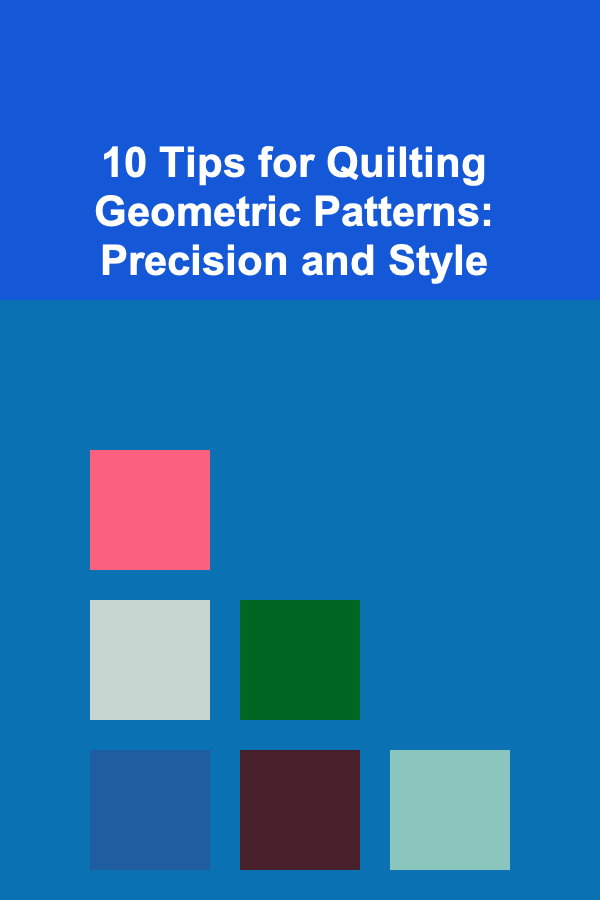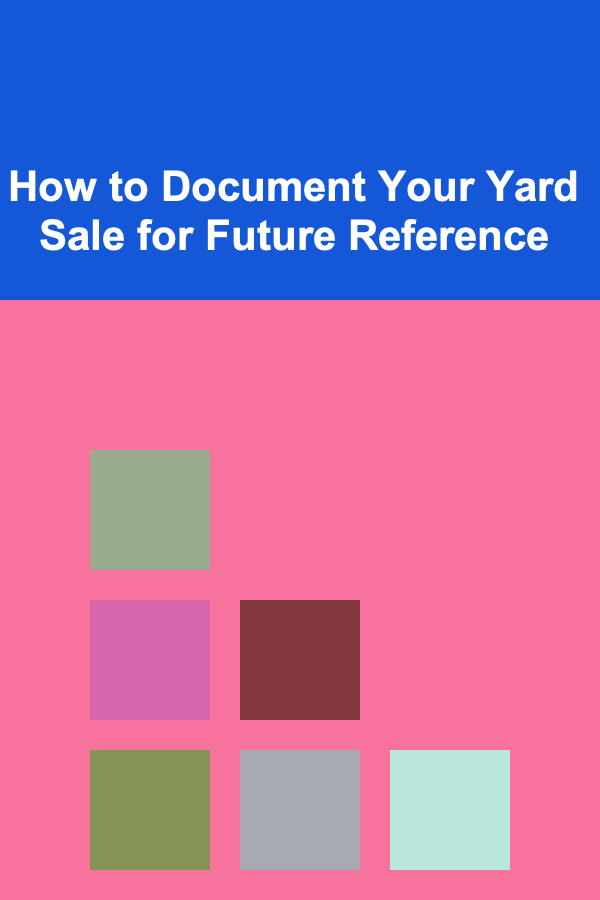
10 Tips for Quilting Geometric Patterns: Precision and Style
ebook include PDF & Audio bundle (Micro Guide)
$12.99$11.99
Limited Time Offer! Order within the next:

Quilting is an art form that has been practiced for centuries, with roots in many cultures. From traditional designs to modern interpretations, quilting continues to be a beloved craft. One style that has gained significant popularity is geometric quilting. The crisp lines, bold shapes, and symmetrical patterns create a striking visual effect, making geometric quilts stand out in any room. However, quilting geometric patterns requires a precise approach and attention to detail. In this article, we will explore ten essential tips to help you quilt geometric patterns with precision and style.
Choose the Right Fabric
Fabric selection is the first and perhaps most important step in quilting, especially when creating geometric patterns. Fabrics with clear lines and distinct colors can enhance the visual impact of the geometric shapes. Consider using solid fabrics or fabrics with a subtle texture for the best results. Bright, contrasting colors will make each shape stand out, while neutral tones can create a more subdued, modern look.
When choosing your fabrics, also think about the weight and drape of the fabric. Quilting cotton is the most common choice, but you can experiment with other fabrics like linen or polyester blends for different effects. The key is to choose fabrics that will hold their shape and allow the lines and angles of your geometric pattern to shine.
Use a Rotary Cutter and Ruler for Precision
Geometric quilting demands precise cutting to ensure that all your pieces fit together perfectly. The most effective tool for this is a rotary cutter, which allows you to cut fabric accurately and with less effort than scissors. Combine it with a quilting ruler to make straight cuts and measure your pieces to the exact size you need.
When cutting, take the time to align the fabric correctly on your cutting mat. If necessary, square up your fabric before cutting to ensure straight edges. This step is critical to achieving sharp angles and crisp lines in your geometric pattern. It may take a little longer, but the precision will pay off in the final result.
Use a Design Wall or Layout Space
Before piecing together your quilt top, it's helpful to lay out your geometric pattern on a design wall or large flat surface. A design wall is a great tool for visualizing the layout of your quilt, especially when working with intricate or repeating geometric patterns. It allows you to move pieces around without having to sew them together first, making it easier to experiment with different arrangements.
If you don't have a design wall, try laying out your pieces on the floor or using a large table. Just be sure to keep the layout organized and take photos of your progress as you go, so you can remember the exact configuration before you start sewing.
Pay Attention to Seam Allowances
Precise seam allowances are crucial when piecing together geometric patterns. Even a small variation in your seam allowance can throw off the entire quilt, leading to mismatched corners and uneven edges. A consistent ¼-inch seam allowance is standard in quilting, but it's important to measure and check it before you begin.
To maintain accuracy, use a quilting foot that has a guide for the seam allowance or attach a ¼-inch seam guide to your sewing machine. This will help you achieve consistent seams and keep your geometric shapes aligned throughout the quilting process.
Press Seams Open for Better Alignment
When working with geometric patterns, pressing your seams correctly can make a huge difference in the overall look of your quilt. For geometric patterns with lots of sharp angles and intersecting seams, pressing the seams open is often the best option. This helps reduce bulk at the intersections and ensures that your quilt lays flat and smooth.
Use a hot iron with steam to press your seams open. Be careful not to distort the fabric as you press. If you prefer, you can also press the seams to one side, but make sure you maintain consistency throughout the quilt top to avoid unevenness.
Consider Color Placement and Contrast
The color placement and contrast in your geometric quilt are key to creating a visually striking design. Play with light, medium, and dark tones to create depth and movement in your quilt. High contrast, such as pairing a bold color with a neutral background, will make the geometric shapes pop. Alternatively, using a more harmonious color palette can create a subtle, cohesive look.
When designing your geometric quilt, take time to experiment with color placement before cutting or sewing any fabric. Consider how the colors will interact with each other once the pieces are assembled and how the quilt will look from a distance.
Use a Walking Foot for Even Stitching
When quilting geometric patterns, it's important to have even stitching throughout the quilt. A walking foot is a valuable tool in achieving this, especially when quilting through multiple layers of fabric. A walking foot helps feed the top fabric evenly with the bottom fabric, preventing puckering and shifting while you sew.
If you're quilting a large geometric design with multiple blocks or pieces, a walking foot ensures that your stitches are consistent and your quilt top stays aligned. This is especially important when quilting straight lines or grids, which are common in geometric patterns.
Incorporate Negative Space Effectively
In geometric quilting, negative space---the areas between the geometric shapes---plays an important role in the overall design. Negative space helps emphasize the geometric shapes and adds a sense of balance and flow to the quilt.
Consider how the negative space can enhance the pattern. For example, you might leave large gaps between geometric shapes to create a minimalist effect or fill in smaller spaces with additional quilting or piecing. Be mindful of the relationship between the shapes and the surrounding space to create a quilt that feels cohesive and balanced.
Take Your Time with the Quilting Process
Geometric quilts require a high level of precision, and rushing through the process can lead to mistakes. Whether you're piecing together the blocks, cutting the fabric, or quilting the finished top, it's important to take your time and focus on the details.
If you make a mistake, don't be afraid to undo a few stitches or re-cut a piece of fabric. Quilting is a process, and it's better to take the extra time to get it right than to rush through and end up with a finished quilt that doesn't meet your expectations.
Add Quilting Designs to Enhance the Geometry
Once your quilt top is pieced together, it's time to think about quilting designs. For geometric patterns, quilting can be an opportunity to add another layer of visual interest. Consider quilting along the lines of the geometric shapes to accentuate them or using straight lines to create a grid-like pattern.
You can also experiment with free-motion quilting or other creative techniques to add texture and dimension to the quilt. Just be sure that the quilting complements the geometric design rather than overpowering it.
Conclusion
Quilting geometric patterns requires a combination of precision, creativity, and patience. By following these ten tips, you can achieve crisp, sharp geometric designs that are visually striking and expertly crafted. From choosing the right fabrics to using the proper tools and techniques, each step plays a crucial role in creating a quilt that showcases your skill and artistic vision. Whether you're a beginner or an experienced quilter, geometric quilting offers endless possibilities to express your style and create quilts that will stand the test of time.
Reading More From Our Other Websites
- [Home Holiday Decoration 101] How to Turn Your Stairs into a Holiday Showcase with Simple Decor
- [Home Staging 101] How to Use Mirrors in Home Staging to Create More Light
- [Organization Tip 101] How to Archive Family Heirlooms for Future Generations
- [Personal Care Tips 101] How to Style a Pompadour with Hair Gel
- [Home Security 101] How to Secure Your Home for Elderly Residents
- [Home Staging 101] How to Elevate Your Hallway Staging: Beyond the Basics for a Grand Entrance
- [Whitewater Rafting Tip 101] Gear Up for Fun: Essential Gear and Hacks for a Stress‑Free Rafting Experience
- [Rock Climbing Tip 101] Avoiding Bruises: Practical Strategies for Falling Safely at Home and Outdoors
- [Personal Care Tips 101] How to Get Maximum Volume Without Sticky Hair Using Hair Mousse
- [Organization Tip 101] What Are the Key Principles of Sustainable Home Organization?

How to Document Your Yard Sale for Future Reference
Read More
How to Handle Rental Property Maintenance Issues Effectively
Read More
How to Use Robo-Advisors for Easy Investment Management
Read More
How to Utilize Local Businesses for Charity Partnerships
Read More
The Art of UX Research: Strategies for Understanding Users and Driving Innovation
Read More
10 Tips for Networking and Finding Clients as a Graphic Artist
Read MoreOther Products

How to Document Your Yard Sale for Future Reference
Read More
How to Handle Rental Property Maintenance Issues Effectively
Read More
How to Use Robo-Advisors for Easy Investment Management
Read More
How to Utilize Local Businesses for Charity Partnerships
Read More
The Art of UX Research: Strategies for Understanding Users and Driving Innovation
Read More